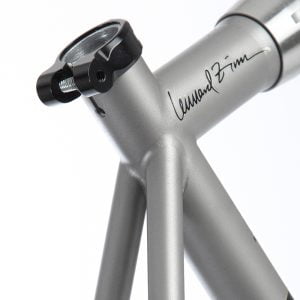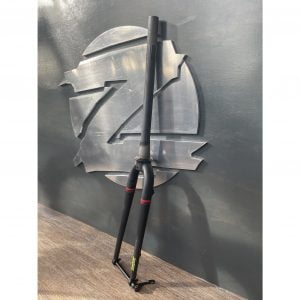 Front-end shimmy, or “high-speed shimmy,” or “death wobble,” is an unpleasant phenomenon that is the bane of many a tall rider. The taller the bike and the heavier the rider, the more likely it is to be an issue.
Front-end shimmy, or “high-speed shimmy,” or “death wobble,” is an unpleasant phenomenon that is the bane of many a tall rider. The taller the bike and the heavier the rider, the more likely it is to be an issue.
I first discovered it in 1981 by virtue of a new bike sponsorship with a new team when I was on the US Olympic Development Team. I was racing the Durango-to-Silverton road race of the Iron Horse Classic in southwestern Colorado. I was the defending champion and course record holder and was hoping to do well, although some recent crashes and illnesses made that unlikely anyway.
The prior year, I’d dropped my breakaway companion on the descents and had won the race thanks to a bike that allowed me to go as fast as I wanted. This time, however, I had already missed the break before the first pass, but I had to drop off of the back of the chase group on the descent of that pass due to my bike shaking uncontrollably once I got up to speed. Hanging on for dear life, I was glad to get down that descent and onto the final climb up Molas Pass. But I dreaded the final drop into Silverton, which indeed required me to brake a lot and go very slowly to stay on the road. It was nothing like the prior year, when I had held a tuck all of the way down both passes and had blown past the lead vehicle. The police car that was supposed to stay ahead of the entire race had been sliding his tires on the switchbacks down to Silverton to stay ahead of me that time, but he would have had no such problem holding my speed this time.
Solving the Problem
After this experience, I was highly motivated to come up with a bike design that would not wobble at high speed. I had a Physics degree, and I had built computer models of bicycle stability while working on it. I had also already built one bike frame for my girlfriend (now my wife) in the Physics shop at Colorado College and in the mechanics’ shop at the Olympic Training Center in Colorado Springs. It took me a while to work out all of the details to make tall bikes shimmy-free, but by 1990, I had it nailed.
 I’ve continued to improve on those designs ever since, including building with titanium and magnesium in addition to steel, designing an improved carbon fork and custom-length cranks for big and tall riders, and now even making full-performance tall bikes that not only don’t shimmy but also unscrew into a number of pieces to fit in a small travel case. Because, first and foremost, I’m a tall rider, and I want my own bikes to allow me to go as fast as I want, with or without hands, in complete confidence, anywhere in the world.
I’ve continued to improve on those designs ever since, including building with titanium and magnesium in addition to steel, designing an improved carbon fork and custom-length cranks for big and tall riders, and now even making full-performance tall bikes that not only don’t shimmy but also unscrew into a number of pieces to fit in a small travel case. Because, first and foremost, I’m a tall rider, and I want my own bikes to allow me to go as fast as I want, with or without hands, in complete confidence, anywhere in the world.
Here is a letter I recently got from one of my customers who is 6’7” and 245 pounds – body dimensions virtually guaranteed to produce death wobble on any bike other than a Zinn!
“I was the victim of front wheel wobble and ended up with a broken elbow this last December… I was riding one of my other bikes; it was a [brand deleted] design with a fairly steep rake on the fork. I was only going 10 mph, I reached down with one hand to grab a water bottle, the other hand lightly on the handlebar. Unfortunately for me, I did not have a secure grip. I sat upright to take a drink, my hand came off the handlebar for only a second, the front wheel went into a violent “speed wobble” motion and flipped me. Result: broken elbow.
Lennard, when you built the custom bike for me (a titanium road bike), I am 6’7” to refresh your memory- 2008 model with 220 mm Zinntegrated cranks, we talked about this issue of front wheel wobble or instability and you assured me that your bike does not have this problem. I have not had a problem with my Zinn bike, but almost all the other frames I have do have a problem either with front-wheel wobble when I remove my hands from the handlebars or the bike does not readily track straight. I have triple-checked to ensure that the wheels are aligned in the dropouts to prevent “crabbing”, however, I am unable to balance the bike and ride hands free.
I see many other riders that are able to ride hands free when they take off or put on their rain jackets, when they “rest while unwrapping a power bar”, or in a similar manner they momentarily ride hands free. Why am I having such a problem? Is it because of the steep fork angle on the bikes? Am I moving my weight too far to the rear wheel? Why am I having this problem? I have been aware of the instability and have tried to be more aware, yet I still had an accident. What can I do to stabilize the bike to prevent future accidents?
-Jim Brogden”
Bikes wobble at high speeds when they hit a resonant frequency, which causes the back-and-forth flexing oscillation to build and build until the bike can hardly be controlled. It is not an indicator of instability, even though the bike is highly unstable when shimmying; it can be an extremely stable bike just a few miles per hour slower. A heavier rider will also tend to cause a bike to shimmy that a lighter rider of the same height might not.
Jim also mentions bikes that don’t track well, but that’s a different issue, also related to tall bike designs, that will have to wait for another time.
The Process
 I eliminate shimmy by increasing the resonant frequency of the bike, which means making it stiffer, as well as addressing that tracking concern Jim mentions. Bikes that shimmy badly tend to be ones that are very flexy, so it takes a long time to make a single back-forth oscillation. It is especially common with tall bikes, particularly ones with small-diameter tubes. All of that open space in the frame allows it to flex back and forth easily.
I eliminate shimmy by increasing the resonant frequency of the bike, which means making it stiffer, as well as addressing that tracking concern Jim mentions. Bikes that shimmy badly tend to be ones that are very flexy, so it takes a long time to make a single back-forth oscillation. It is especially common with tall bikes, particularly ones with small-diameter tubes. All of that open space in the frame allows it to flex back and forth easily.
I build in this stiffness without adding much weight simply with logical design choices, including larger-diameter tubes, lowered and sloped top tube, extended head tube, raised bottom bracket (for longer cranks), optimized front-end geometry, and the Alpha Q Z-Pro fork I helped design, which has a much stiffer (and longer!) steering tube than other carbon forks.
Some tall bikes with a shimmy could be made not to wobble at high speed simply by replacing the top tube with a stiffer one – this may be the single most important frame member to stop the death wobble. More minor things also contribute, like flexy wheels, pitted headsets, untrue wheels, wobbly tires and out-of-balance wheels. To illustrate the latter, if you crank your rear wheel up to high speed on a work stand, the whole stand will jump up and down because the wheel is so out of balance. When you let a wheel spin down without resistance, it will usually stop with the valve at the top, since the rim seam is heavier. Using a tube with a longer valve, and/or screwing on valve collars will help balance the wheel, similar to how tire stores do it for your car (and you know how shaky a car with unbalanced wheels can be).
My answer to Jim would be that he should try the stiffest, balanced wheels he can find in those non-Zinn bikes of his that shimmy. And if that doesn’t fix it, there’s not much more he can do. A third-hand quote I heard attributed to Eddy Merckx went like this- When answering someone who asked him how to get rid of a shimmy in a bike, The Cannibal is said to have replied, “sell the bike!”
 Often, replacing the bike frame and fork with ones designed not to wobble at high speed is indeed the only alternative, because you can only make minor improvements with different components. In the meantime, I’d want Jim to know that immediately clamping his knees against the top tube may be enough to dampen a shimmy right when it gets started and could save him from crashing.
Often, replacing the bike frame and fork with ones designed not to wobble at high speed is indeed the only alternative, because you can only make minor improvements with different components. In the meantime, I’d want Jim to know that immediately clamping his knees against the top tube may be enough to dampen a shimmy right when it gets started and could save him from crashing.
That may not be enough for some bikes, and there may be another way – a way that Rolf Dietrich, designer of Rolf Prima wheels, told me about but I’ve not tried (because I no longer have any bikes that shimmy!).
Think of a kid’s telephone made by attaching two tin cans together with a string. The vibrations will only travel down the string when it is taught. Similarly, if the bike is only touching the road with one wheel, it can’t shimmy. While I don’t know many riders skilled enough to yank a shimmying bike into a wheelie, you may be able to stop a shimmy once it’s started by pushing your weight as far back as you can off of the back of the saddle to take as much weight as possible off of the front end. This quite clearly would take a leap of faith, and you would have to choose either it or clamping your knees against the top tube at the moment it happens, because you won’t be able to do both at the same time.
The best way, of course, is to have a bike that doesn’t shimmy. The bike I built for Jim is a huge bike, as may be the bike I built for you. But it does not wobble despite being built out of titanium, which the conventional wisdom among cyclists says is a flexy material. Intelligent design and a commitment to making tall bikes that are safe to ride at high speed or without hands made the difference. Schedule a fitting with Zinn and get rid of death wobble once and for all.


